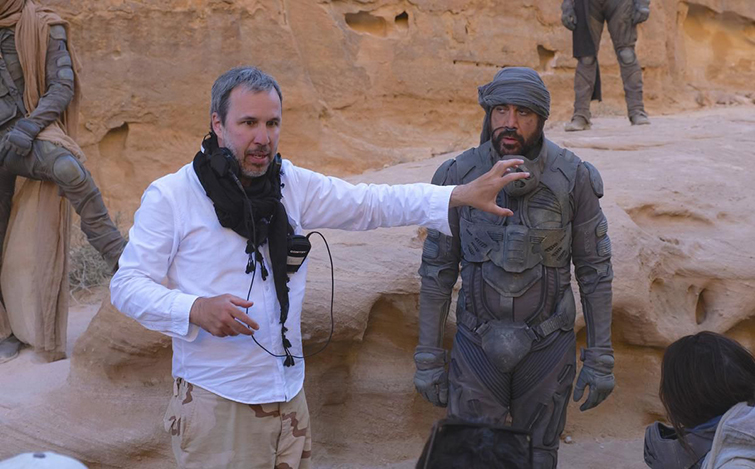
The Box Office Divide: How a “Dune” Sequel May Save Cinema
Let’s explore what this Dune sequel will need to do to give cinema a second chance, and a new life, in our hybrid streaming/theatrical future.
Make no mistake, we’re at a critical time in cinema history. Never has the shared and sacred theatrical experience been more in peril. On the cusps of a rising streaming behemoth, and still in the grips of a pandemic, cinemas are battling for their ultimate survival.
And, while many films and filmmakers have already been extinguished (like Christopher Nolan and his valiant but ultimately commercially futile blockbuster Tenet), there’s one movie left which might cinematically save us all.
That movie is Dune, which quite fittingly is about a messiah character who emerges from the dusty wastelands of a desert planet. With the recent news that Dune had done enough to prove to studio execs that it deserves a part two, this Dune sequel is already shaping up to be perhaps the final battle for cinema’s future.
Let’s see how we got here . . .
The Growing Box Office Divide
As we’ve covered in the past here on PremiumBeat, there’s been a growing divide in modern cinema between big-budget blockbusters and small indie productions. There used to be a healthy middle ground that’s all but disappeared at this point. (Will streaming replace it? We’ll have to wait and see.)
Dune is, of course, in the blockbuster camp. While it might not be of the scale and budget of your biggest Marvel superhero films, it’s certainly a colossal production undertaking that requires thousands of people to complete. With its reported budget in the $165 million range, it would have needed to return at least twice that to “break even,” as they say in the industry.
At last count, Dune has currently just eclipsed the $300 million mark for worldwide box office returns, which should get it pretty close to covering all the costs for productions and marketing (the latter of which is usually calculated roughly at half the production budget).
However, there’s more to the story than just the box office returns, at this point. And, while Dune might not be the poster child for middle-budget feature films, it does share some hallmarks that we’ve associated with non-blockbuster films over the years.
Denis Villeneuve vs. Streaming Services

The most interesting aspect to the story of Dune’s release comes down to its release model. Director Denis Villeneuve is the latest in a long-line of big-budget directors to fight for their films to be released in theaters only at first.
However, just as Christopher Nolan before him failed due to health concerns with his film Tenet, Dune was ultimately released with a hybrid streaming and theatrical model.
Simply put, if you thought it might be hard to release a film during a pandemic, which has seen theaters across the globe shutter and audiences often opt to stay home, it’s doubly hard to release a film in theaters when you also release it online for free (for anyone who subscribes to your streaming service, in this case HBO Max).
As such, Villeneuve lost his fight to keep Dune exclusively in theaters. Yet, the film was still able to hit its break-even point. Which means, it may have hit much greater box office numbers had it been released exclusively in theaters, or perhaps at any other given time.
The Future of Dune Part II
But, what does this spell for the future of Dune and for cinema? Well, it means a couple of things. For one, theaters aren’t dead. Having a film earn $300 million worldwide used to be unprecedented territory. Nowadays, it’s run of the mill for a big-budget blockbuster, but it’s still impressive nonetheless.
It’s also one of the top-grossing films to come out since the first pandemic shutdowns. Many theaters, unfortunately, have closed since then. But, for the ones that were lucky enough to stay open, they were given a big hit to draw audiences back in.
When Dune was sitting at around the $200 million box office mark, a sequel was finally officially greenlit. HBO and their partners were waiting to see if Dune would earn its keep, so to speak. And, apparently, at that point, it had done enough.
We’ll perhaps never know just how well Dune did on streaming services in terms of how many new subscriptions it drew for HBO Max, or just in terms of general brand recognition. However, despite all the factors working against it, Dune’s box office returns and favorable reviews alone have proven that a big-budget feature can still justify keeping the lights on at your local movie theater.
And, with Villeneuve’s request that Dune Part II be released in theaters only when it comes out two years from now, he’s further working to ensure that theaters will be here to stay long into the future.
Fore more industry insights and filmmaking tips, check out these articles:
- 5 Reasons Why David Lynch’s Dune Kind of Rules
- Exploring the History and Revival of the 4:3 Ratio
- Lamb: Arthouse Horror and the Rise of a New Genre
- What “The Invisible Man” Can Teach Aspiring Suspense Filmmakers
- A24 vs Marvel Pt 2: Why This Debate Is Necessary (But Sucks)
Cover image via Warner Bros.





